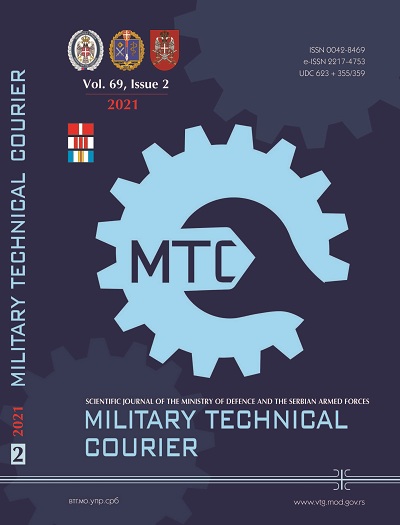High energy microwave weapon - еlectromagnetic bomb
Abstract
Introduction/purpose: Technological progress has led to the actualization of the problem of construction and use of high-energy microwave weapons, especially electromagnetic bombs. However, in the recent military-professional literature, this issue is little represented.
Methods: The available existing literature on the subject was analyzed.
Results: It has been established that the general principles of functioning and theoretical bases have been widely available and known for many years. Numerous experiments in specialized institutions have confirmed the electromagnetic pulse effectiveness. This is especially true of sensitivity of devices based on semiconductor technology. Also, it is assumed that, at the current technological level, technical solutions are widely available to a large number of entities. The most common model of electromagnetic bomb dealt with in the literature is the realization of the use of a compression flux generator and an oscillator with a virtual cathode. According to the authors, this variant would ensure that the final product has realistic physical dimensions and sufficient strength to be useful. Another problem identified in the literature is the massive absence of adequate protection measures against the effects of electromagnetic pulses. This applies not only to the civilian but also to the military sector and imposes the need to invest significant resources in order to subsequently increase resilience.
Conclusion: The available literature indicates that it is possible to make an electromagnetic bomb of acceptable physical dimensions and power. It is assumed that it would generate an electromagnetic pulse with a power of about 10 GW and a frequency of 5 GHz. In combination with high-precision weapons, even protected devices would be successfully disabled. The wide presence of semiconductor technology in all spheres of life makes this weapon extremely effective and it is realistic to expect its much wider application in the coming period.
References
Abrams, M. 2003. Dawn of the E-Bomb. IEEE Spectrum, 40(11), pp.24-30. Avalable at: https://doi.org/10.1109/MSPEC.2003.1242953.
Arnesen, O.H., Krogager, E., Backstrom, M., Bo-Sande, S., Godo, J., & Harkonen, S. 2005. High power microwave effects on civilian equipment. In: Proceedings of 28th General Assembly of the URSI, India, New Delhi, October 23-29.
Bäckström, M., Lövstrand, K.G. & Nordström, B. 2002. The swedish microwave test facility: technical features and experience from system testing. In: Proceedings of 27th General Assembly of the URSI, The Netherlands, Maastricht, August 17-24 [online]. Available at: https://www.ursi.org/proceedings/procGA02/papers/p0451.pdf [Accessed: 28 September 2020].
Commission to Assess the Threat to the United States from Electromagnetic Pulse (EMP) Attack. 2017. Assessing the Threat from Electromagnetic Pulse (EMP): Executive Report [online]. Available at: http://www.firstempcommission.org/uploads/1/1/9/5/119571849/executive_report_on_assessing_the_threat_from_emp_-_final_april2018.pdf [Accessed: 28 September 2020].
Dražan, L. & Vrána, R. 2009. Axial Vircator for Electronic Warfare Applications. Radioengineering, 18(4), pp.618-626 [online]. Available at: https://www.radioeng.cz/fulltexts/2009/09_04_618_626.pdf [Accessed: 28 September 2020].
Foster, J.S., Gjelde, E., Graham, W.R., Hermann, R.J., Kluepfel, H.M., Lawson, R.L., Soper, G.K., Wood, L.L. & Woodard, J.B. 2008. Report of the Commission to Assess the Threat to the United States from Electromagnetic Pulse (EMP) Attack: Critical National Infrastructures. Fort Belvoir, Virginia: Defense Technical Information Center [online]. Available at: https://apps.dtic.mil/sti/citations/ADA484672 [Accessed: 28 September 2020].
Kopp, C. 1996. The electromagnetic Bomb – a Weapon of Electric mass destruction. Fort Belvoir, Virginia: Defense Technical Information Center [online]. Available at: https://apps.dtic.mil/sti/citations/ADA332511 [Accessed: 28 September 2020].
Miller, C.R. 2005. Electromagnetic Pulse Threats in 2010. Fort Belvoir, Virginia: Defense Technical Information Center [online]. Available at: https://apps.dtic.mil/sti/citations/ADA463475 [Accessed: 28 September 2020].
Ni, G., Gao, B. & Lu, J. 2005. Research on High Power Microwave Weapons. In: Asia-Pacific Microwave Conference Proceedings, Suzhou, China, p.4, December 4-7. Available at: https://doi.org/10.1109/APMC.2005.1606492.
Vasilevich, S.V. & Pershenkov, V.S. 2016. Electromagnetic pulse effects and damage mechanism on the semiconductor electronics. Facta universitatis - series: Electronics and Energetics, 29(4), pp.621-62. Available at: https://doi.org/10.2298/FUEE1604621S.
Proposed Creative Commons Copyright Notices
Proposed Policy for Military Technical Courier (Journals That Offer Open Access)
Authors who publish with this journal agree to the following terms:
Authors retain copyright and grant the journal right of first publication with the work simultaneously licensed under a Creative Commons Attribution License that allows others to share the work with an acknowledgement of the work's authorship and initial publication in this journal.
- Authors are able to enter into separate, additional contractual arrangements for the non-exclusive distribution of the journal's published version of the work (e.g., post it to an institutional repository or publish it in a book), with an acknowledgement of its initial publication in this journal.
- Authors are permitted and encouraged to post their work online (e.g., in institutional repositories or on their website) prior to and during the submission process, as it can lead to productive exchanges, as well as earlier and greater citation of published work (See The Effect of Open Access).

